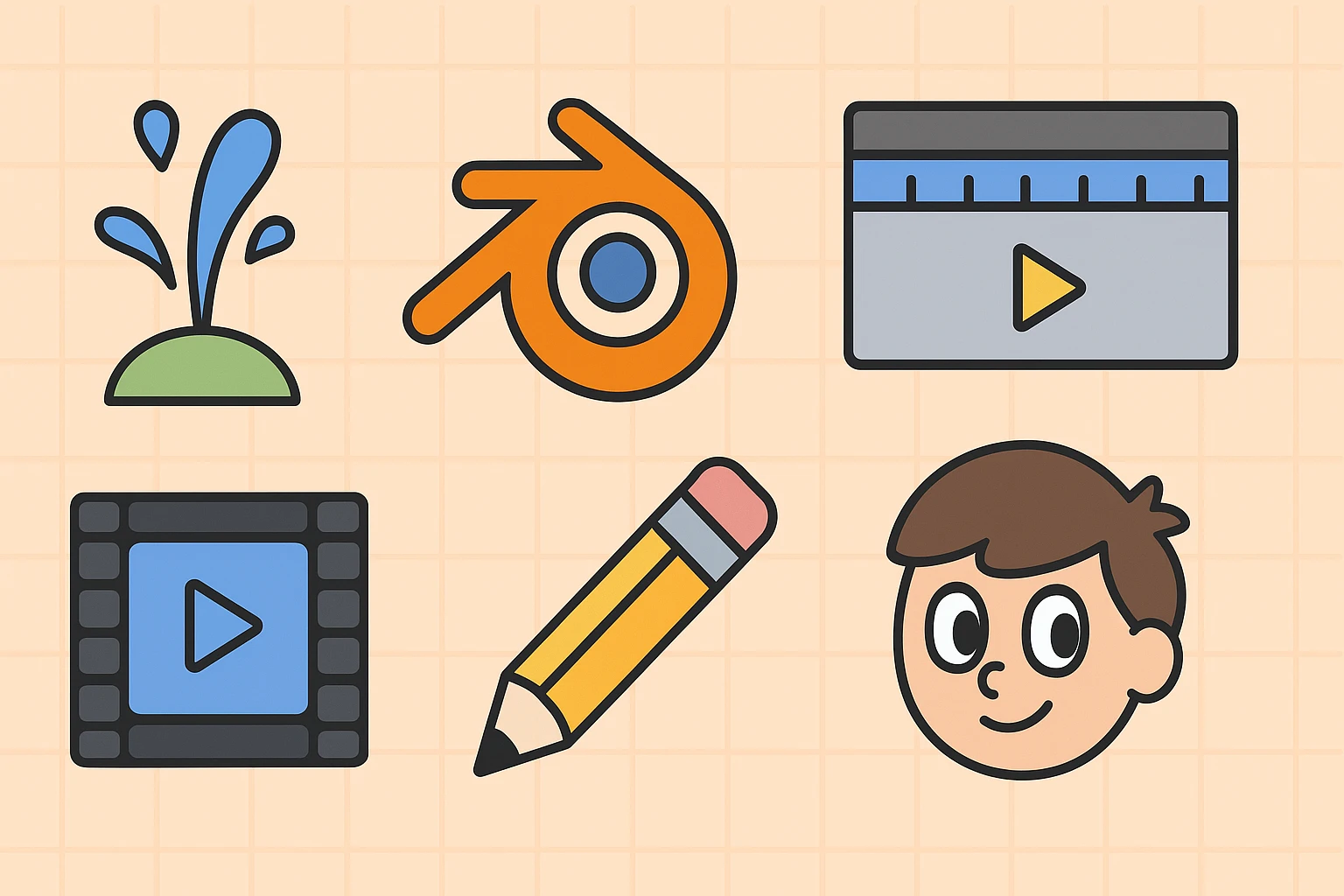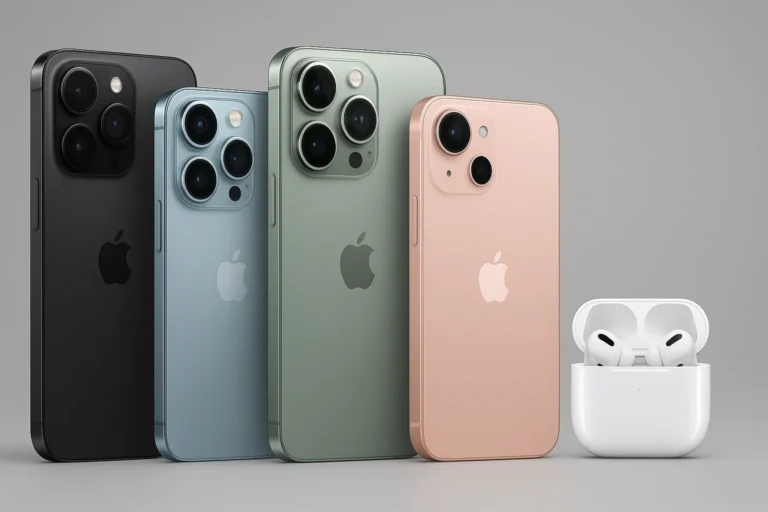The Best Free Animation Software for Beginners in 2025
Table of Contents
Animation can feel intimidating – expensive software and tricky tools – but today there are plenty of free animation software for beginners that let you dive in without spending a dime. Even Hollywood-quality tools are open-source now. For example, Blender is a free, open-source 2D/3D animation suite used by pros and hobbyists alike. In this guide we’ll take a friendly look at the best easy animation tools you can try first. Whether you want classic 2D hand-drawn cartoons or 3D models, there’s a free animation software for beginners waiting for you. We’ll cover Blender, Synfig Studio, OpenToonz, Pencil2D, Krita, and TupiTube – explaining what each is good at and where it might be too much (or too little) for a newbie. We’ll also suggest simple starter projects and tips for how to learn animation free on a budget.
Blender
Blender is a powerhouse of free animation software. It’s 100% free, open-source, and runs on Windows/Mac/Linux. Blender supports both 3D and 2D (through its Grease Pencil tool) – you can model, rig, and animate characters or draw frame-by-frame cartoons. Its strengths are versatility and customizability: “Every tool can be scripted” and you can add physics, sculpt models, use motion tracking, special effects, and more. For example, Blender’s Grease Pencil lets you draw in 3D space, making it possible to mix 2D animations with 3D scenes. The community is huge, so you’ll find tons of free tutorials and add-ons.
That said, Blender can be overwhelming at first. Its interface is complex and the learning curve is steep. If you just want an easy animation tool, it might feel overpowered. But if you stick with it, Blender is incredibly powerful and truly free animation software for beginners to grow into. A great starter project is to model a simple shape (a bouncing ball or a rotating cube) and animate it with physics. Or try Grease Pencil to animate a short 2D walk cycle. Even if it takes patience, Blender rewards you with industry-level features and community support.
Synfig Studio
Synfig Studio is free and open-source 2D animation software designed for “film-quality animation” using vector and bitmap artwork. In other words, it’s a powerful tool for animating shapes without redrawing every frame. Synfig’s key feature is tweening: you set key positions for your characters or shapes and Synfig automatically generates the in-between frames. It also has a bone system for puppets, filters, and even a scripting engine. This makes Synfig one of the best easy animation tools for motion graphics style or cut-out animation on a budget.

Because Synfig skips frame-by-frame drawing, it’s great for creating smooth animations with fewer drawings. However, Synfig’s interface can feel foreign if you’re used to traditional frame-by-frame software. It has advanced controls (linking layer parameters, skeleton distortion, etc.), so it might not be the simplest way to learn animation free at the very beginning. In fact, users say Synfig isn’t “made for beginners” But once you get the hang of it, Synfig can produce professional-looking 2D cartoons and explainer videos. A nice starter project is to design a simple character and use the bone system to animate a short cycle (like waving or walking). This way you explore how vector tweening works without drawing every frame.
OpenToonz
OpenToonz is a feature-packed 2D animation suite that’s completely free for both personal and commercial use. In fact, it’s the open-source version of the software used by Studio Ghibli! It offers hand-drawn frame-by-frame animation plus many production tools. You get both vector and bitmap drawing options, layers, indexed color palettes, and an effect/compositing system with over 100 filters (like blurs and lights). There’s also motion tweening, a particle system for rain or snow, and even a scanner module to turn pencil sketches into clean line art.

For a beginner, OpenToonz can seem like a lot – its interface and feature list are extensive. But it’s extremely powerful for 2D animation, and the fact that it’s completely free makes it a top choice. You’ll find built-in onion-skinning and a timeline, and its user community is active (including a Google Groups forum and GitHub discussions). OpenToonz is best for cartoon-style or traditional animations. To get started, try a simple paper animation: draw a sequence of frames on paper, scan them, then color and play them back in OpenToonz. Or create a digital flipbook of a character waving. This “starter project” approach helps you learn the frame-by-frame workflow without getting lost in too many settings.
Pencil2D
Pencil2D is a very beginner-friendly 2D animation tool. It’s lightweight and entirely open-source. The interface is minimal, so you won’t waste time hunting through menus – you can “focus on animating and not what button to hit next”. Pencil2D supports both raster (bitmap) and vector drawing, and you can switch between them as you sketch, ink, and color. It runs on Windows, Mac, Linux (and even FreeBSD).

This simplicity makes Pencil2D one of the easiest animation tools out there. It has just enough features (onion-skinning, layer support, audio import, etc.) to create hand-drawn animations without overwhelming a newbie. It’s not packed with advanced extras, but that’s by design – Pencil2D lets you start drawing animated cartoons fast. A great first project is a classic: animate a bouncing ball or a walking stick figure. Draw a few key poses, use the onion-skin feature to align them, and hit play. The simple interface means you’ll spend time on creativity instead of learning the software. (Note: since it’s open-source, it’s also completely free animation software for beginners – even commercial use is allowed.)
Krita
Krita is best known as a free digital painting program, but it has a solid animation feature set built in. If you love drawing with brushes, Krita can turn into a mini animation studio. Its Animation Workspace provides a timeline, frame-by-frame playback, and onion-skinning so you can see surrounding frames. You can import audio, work with multiple layers, and even use brush stabilizers for smoother lines. Krita supports thousands of frames on the timeline and lets you export your animation as a video or image sequence.
For beginners, Krita is a nice way to learn 2D animation if you already like drawing. The learning curve is moderate – the interface isn’t as simple as Pencil2D, but it’s more intuitive than professional animation suites. A fun starter project is to sketch a short 10-frame walk cycle or a character saying a word. Use the onion-skin feature to tweak each frame. Krita’s canvas tools (pressure sensitivity, huge brush library) make drawing enjoyable. The downside is Krita doesn’t have built-in tweening – you animate mostly by hand – so it’s more for traditional animators. Overall, if your goal is to learn animation free by drawing, Krita is among the best free tools for the job.
TupiTube Desk
TupiTube (specifically TupiTube Desk for computers) is an easy 2D animation app aimed at kids and absolute beginners. It’s open source under the GPL, meaning it’s totally free for hobby use. TupiTube’s interface is very clean and simple – you won’t be intimidated by a million panels. It offers basic drawing and painting tools plus a timeline for frame-by-frame 2D animation. You can import images or vectors, and do simple transforms (scale, rotate, opacity) on them.
TupiTube is one of the most beginner-friendly free animation software for beginners you’ll find. Because it’s designed for “children and teenagers”, the focus is on having fun, not professional features. You can export your animations as SWF, MPEG, AVI or other formats. To try it out, draw a shape or character in one frame, then slightly move it in the next frames – sort of like a digital flipbook. A good starter project is a little animated sticker or emoji moving across the screen. This helps you get comfortable with the basics of frame-by-frame animation before moving on to more complex tools.
Also Check OUT Best Noise Cancelling Headphones for Gaming in 2025
Tips: How to Learn Animation for Free
You might be wondering, “Where do I go from here?” The good news is there are tons of free resources to help you learn animation on a budget. Many artists share tutorials on YouTube, Twitch, and forums, so you can learn animation free with videos and community help. For example, Blender’s YouTube channels (like Blender Guru or tutor4u) have step-by-step guides. Synfig and Pencil2D have active forums and Discord communities where beginners ask questions and share tips. Don’t overlook the official documentation and tutorials on each program’s website – those are free and super helpful.
Here are some quick tips and starter steps:
- Start small. Animation takes time, so pick a simple project (bouncing ball, walk cycle, etc.) and finish it. Completing something small feels great and teaches a lot.
- Use beginner courses. Some sites (like Noble Desktop or even Coursera/edX) offer free intro classes on animation basics. These often use free software (even if the site itself is promoting paid courses).
- Watch and learn. YouTube is packed with “How to animate” tutorials – both software-specific (e.g. “Animate with Pencil2D”) and general animation principles (e.g. squash-and-stretch, timing). Many tutorials are free and start from zero.
- Join communities. Subreddits like r/learnanimation or software-specific forums (e.g. Blender Artists, Synfig forums) are full of beginner questions and friendly advice. Seeing others’ work and asking questions is a great way to progress.
- Practice drawing basics. Even for digital animation, hand-drawn skills help. Try pencil-and-paper sketching or frame-by-frame in a simple program to get the hang of motion.
Conclusion
Animation doesn’t have to stay a distant dream just because you’re on a budget. Today’s free animation software for beginners means anyone can start creating cartoons and motion graphics without buying expensive tools. Programs like Blender, Synfig, OpenToonz, Pencil2D, Krita, and TupiTube make it easy to get hands-on experience. With each of them free to download, you can experiment and find what feels right. Combine those easy animation tools with plenty of free online tutorials and communities, and you’re all set to learn animation free and have fun. Who knows – the next viral animation could be yours, made on your own computer with nothing but creativity and these free programs!








